Welcome to the world of the majestic blue birds of South Dakota! This beautiful species of birds is found throughout the state, from the plains and prairies to the forests and wetlands. They are a treasured part of the state’s wildlife and are a source of great joy for many.
Whether you’re a birdwatcher or just a casual observer, the blue birds of South Dakota provide an excellent opportunity to observe and enjoy nature. With their bright blue feathers, they are sure to add a splash of color to any landscape.
You will learn more about these beautiful birds, their habitats, behavior, and more here. So, explore the world of the bluebirds of South Dakota!
11 Blue Birds in South Dakota
If you love bluebirds, you will be delighted that South Dakota is home to 11 different species of these colorful creatures. From the common blue jay to the rare mountain bluebird, these birds add beauty and diversity to the state’s ecosystems.
Here are 11 bluebirds in South Dakota, and share some interesting facts about them.
1. Eastern Bluebird
The eastern bluebird is a small thrush native to North America. A migratory species move between different habitats depending on the season. It is typically found in open woodlands, farmlands, and orchards.
The male bluebird is particularly striking, with its bright blue breeding plumage. This vivid coloration can be easily seen when the bird is perched on a wire or other open perch, making it a desirable sighting for birdwatchers.
The eastern bluebird is an attractive species, and many birders enjoy observing its beautiful plumage.
| Kingdom | Animalia |
| Phylum | Chordata |
| Class | Aves |
| Order | Passeriformes |
| Family | Turdidae |
| Genus | Sialia |
| Species | S. sialis |
2. Mountain Bluebird
The mountain bluebird is a beautiful migratory small thrush found in the mountainous regions of western North America. It boasts a light underbelly and dark, obsidian eyes.
The adult males have thin bills and are a stunning, bright turquoise blue, fading to a slightly lighter hue on their underside. This iconic bird is a pleasure to behold, and its vibrant colors can make an otherwise dull landscape appear alive and vibrant.
Its migratory nature makes it a fascinating creature, as its movements are unpredictable and can change with the seasons. It symbolizes the beauty of nature and its power to transform an environment.
| Kingdom | Animalia |
| Phylum | Chordata |
| Class | Aves |
| Order | Passeriformes |
| Family | Turdidae |
| Genus | Sialia |
| Species | S. currucoides |
3. Blue Jay
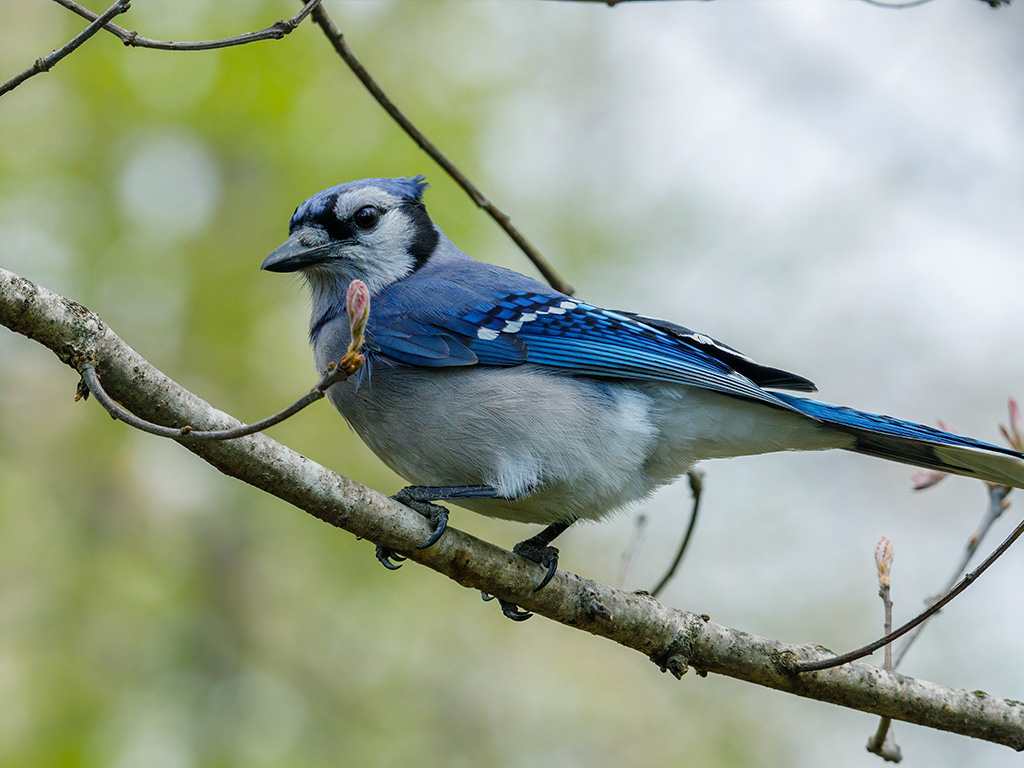
The blue jay is a bird that belongs to the family Corvidae and is native to the eastern part of North America. It is found in most eastern and central United States, and some of its eastern populations may migrate.
It has permanent resident populations in Newfoundland, Canada, and breeds across southern Canada.
Its range is quite broad, stretching from the east coast of the United States through the Midwest and as far north as Canada. Blue jays are easily recognizable by their bright blue feathers and white markings on their wings, tail, and crest.
They have a distinctive call that is loud and harsh, which can be heard from a distance. Blue jays are omnivorous, meaning they eat both plants and animals. They are known to feed on nuts, seeds, fruits, and insects, as well as the eggs and chicks of other birds.
They also steal food from other birds, such as suet from backyard bird feeders. Blue jays are social and often seen in small flocks or groups. They are also quite vocal and usually chatter and chirp in the trees.
In addition to eating, they often engage in playful behavior, such as chasing each other in the air or playing tag with their mates.
They are also important seed dispersers, known to transport and store acorns and other seeds in caches. Overall, the blue jay is an iconic bird species of North America, recognizable by its bright blue feathers and distinctive call.
It is found in many habitats and has permanent resident populations in Canada and the United States. They are omnivorous and often seen in small flocks. They are important seed dispersers and engage in playful behavior.
| Kingdom | Animalia |
| Phylum | Chordata |
| Class | Aves |
| Order | Passeriformes |
| Family | Corvidae |
| Genus | Cyanocitta |
| Species | C. cristata |
4. Barn Swallow
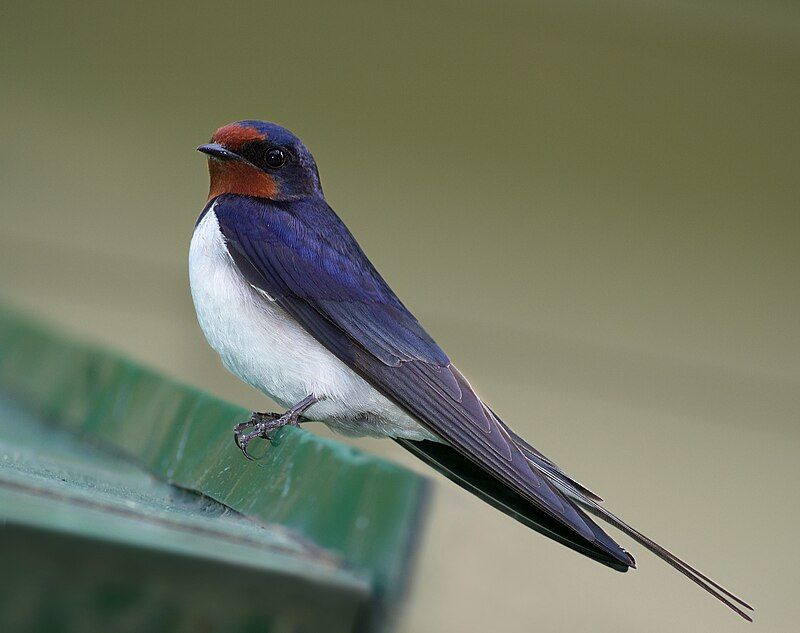
The barn swallow is a bird species with the most comprehensive natural range of any passerine bird in the world. This species is found on every continent except Antarctica, covering an area of over two hundred and fifty-one million square kilometers.
Barn swallows have a distinct look; they have bright blue feathers and long forked tails on their upper body. This swallow species is also known for its aerial acrobatics, as it uses its agility to swoop and dive in pursuit of insects.
They are often seen flying in flocks, often in groups of more than ten. The barn swallow is a migratory bird, meaning they will fly to different parts of the world to find suitable nesting and feeding grounds.
During the winter, they migrate to warmer climates to survive the cold temperatures.
They use their long tails and wings to steer and navigate in flight, allowing them to fly quickly and accurately. The barn swallow has adapted to live among humans, and they often nest in barns, stables, and other human dwellings.
They feed on insects such as flies, midges, and mosquitoes. The barn swallow is a significant species worldwide, essential in controlling insect populations.
In conclusion, the barn swallow is a unique species that has adapted to live among humans and has an extensive range. It is a distinctive bird with blue upperparts and a long forked tail, and they are known for their aerial acrobatics.
They are essential for controlling insect populations and are a beautiful species that deserve our respect and protection.
| Kingdom | Animalia |
| Phylum | Chordata |
| Class | Aves |
| Order | Passeriformes |
| Family | Hirundinidae |
| Genus | Hirundo |
| Species | H. rustica |
5. Common Grackle
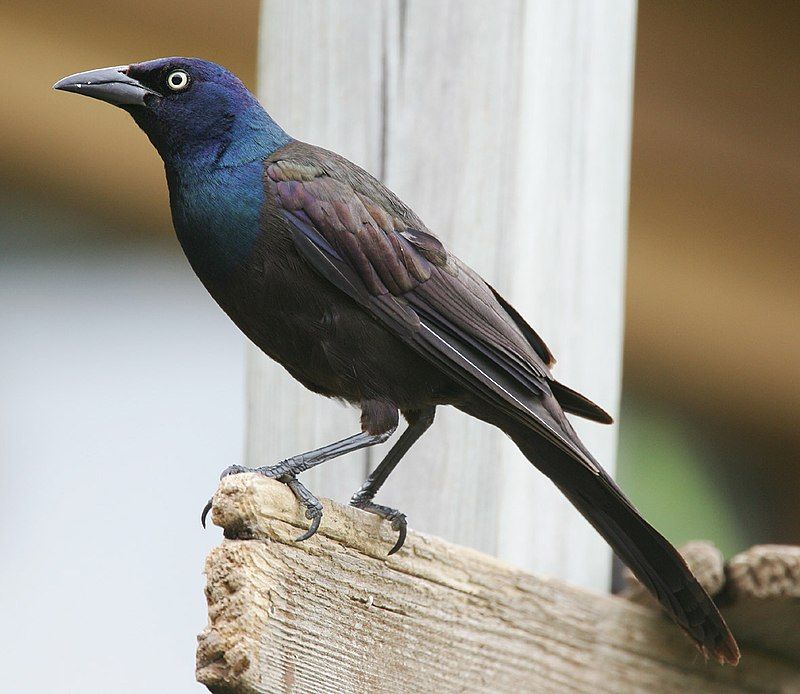
The common grackle is a species of large icterid bird found in abundance throughout much of North America. The common grackle has three distinct subspecies, first documented in 1758 by Carl Linnaeus.
Adult common grackles typically have a long, slender bill, pale yellow eyes, and long tails. These birds are primarily black, with a glossy green and purple sheen on their upper parts.
The male grackles are even more striking in appearance, with a bright yellow-orange patch on their upper wings and tail feathers. Common grackles are known to be highly social birds, often found in large flocks in open areas.
They feed mainly on insects but also eat various fruits and seeds. They also hunt small vertebrates, such as lizards and mice.
In addition to their diet, common grackles also take advantage of human-provided food sources, such as garbage and bird feeders. Common grackles are often found near humans, making them easily recognizable and popular.
They are also noted for their loud and often raucous calls, which can be heard in the late summer and early fall months. Despite their noisy behavior, common grackles are essential to many ecosystems and help control harmful insect populations.
| Kingdom | Animalia |
| Phylum | Chordata |
| Class | Aves |
| Order | Passeriformes |
| Family | Icteridae |
| Genus | Quiscalus |
| Species | Q. quiscula |
6. Cyanocitta
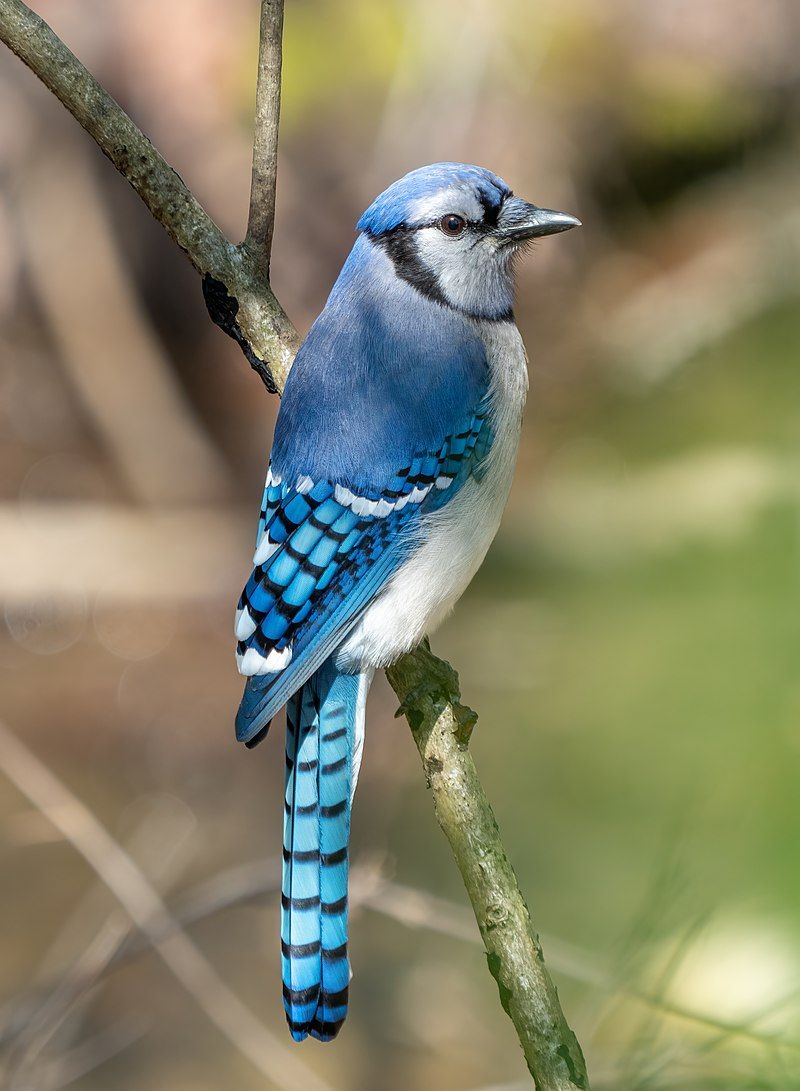
Cyanocitta is a genus of birds that belongs to the Corvidae family. This family also includes crows, jays, and magpies. The genus was first established by Hugh Edwin Strickland in 1845 and currently contains several species.
Cyanocitta is derived from two Greek words: guanos, meaning “dark blue,” and kitten, meaning “jay.” This reflects that many of the birds in this genus have blue feathers, making them easily recognizable.
The genus Cyanocitta is an excellent example of how the scientific naming system can be used to describe the physical characteristics of different species of birds.
| Kingdom | Animalia |
| Phylum | Chordata |
| Class | Aves |
| Order | Passeriformes |
| Family | Corvidae |
| Genus | Cyanocitta |
7. Blue Grosbeak
The blue grosbeak is a medium-sized bird that belongs to the cardinal family, Cardinalidae. It is found in North America and is mainly migratory, which means it spends winters in Central America and breeds in the southern United States and northern Mexico.
The male blue grosbeak has a bright blue plumage with two distinct brown wing bars. This unique pattern helps to distinguish it from other birds in the same family.
The blue grosbeak is a common sight in its breeding grounds during the summer months and can often be seen in open woodlands or around fields. It feeds mainly on insects, seeds, and fruits and can be found in large flocks during migration.
The blue grosbeak is an integral part of the North American ecosystem and provides critical ecological services such as pollination, seed dispersal, and pest control.
| Kingdom | Animalia |
| Phylum | Chordata |
| Class | Aves |
| Order | Passeriformes |
| Family | Cardinalidae |
| Genus | Passerina |
| Species | P. caerulea |
8. Lazuli Bunting
The lazuli bunting is a species of North American songbird commonly found in open woodlands, grasslands, and shrublands. It is a small, sparrow-like bird identified by its bright blue plumage, white belly, and white wing bars.
The name “lazuli” derives from the gemstone lapis lazuli, known for its deep blue hue. These birds often hop through the grasses, foraging for insects and seeds, or perched atop a bush singing their loud, melodious song.
Male lazuli buntings are especially vocal during the breeding season, singing from perches to attract a mate. During the winter, they form small flocks and migrate south for warmer climates and more abundant food supplies.
As with many bird species, the lazuli bunting is threatened by habitat destruction, climate change, and the introduction of invasive species.
Conservation efforts are underway to ensure these beautiful birds remain a part of the North American landscape for years.
| Kingdom | Animalia |
| Phylum | Chordata |
| Class | Aves |
| Order | Passeriformes |
| Family | Cardinalidae |
| Genus | Passerina |
| Species | P. amoena |
9. Northern Parula
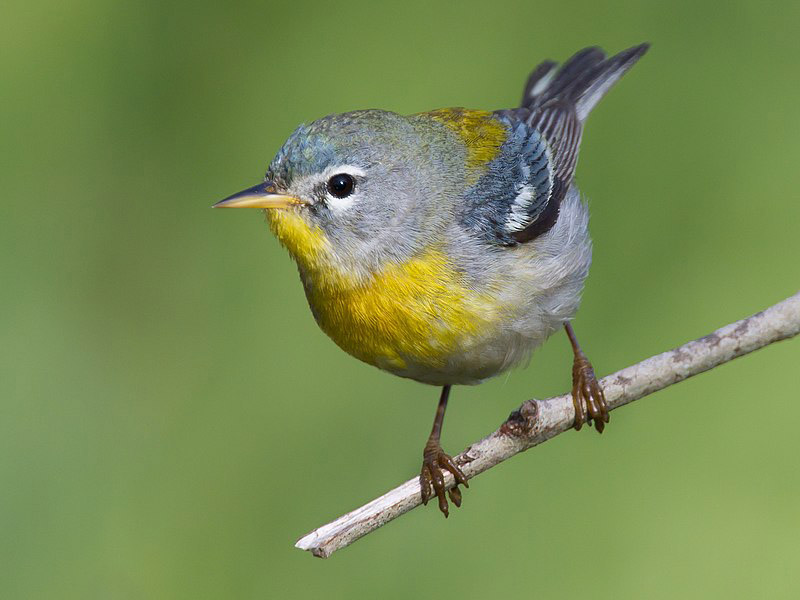
The northern parula is a species of warbler native to North America. This tiny bird is typically found in the eastern part of the continent, ranging from southern Canada down to Florida.
It is a migratory bird, spending the winter months in Central and South America. The northern parula is a songbird, and it is known for its bright yellow-green body and distinctive blue-gray head and tail.
During the breeding season, it builds a cup nest in the fork of a tree, usually close to the trunk. The diet of this species consists of insects, spiders, and other invertebrates, and it forages in trees and shrubs.
The northern parula is a common species and is not considered a conservation concern.
| Kingdom | Animalia |
| Phylum | Chordata |
| Class | Aves |
| Order | Passeriformes |
| Family | Parulidae |
| Genus | Setophaga |
| Species | S. americana |
10. Rivoli’s Hummingbird
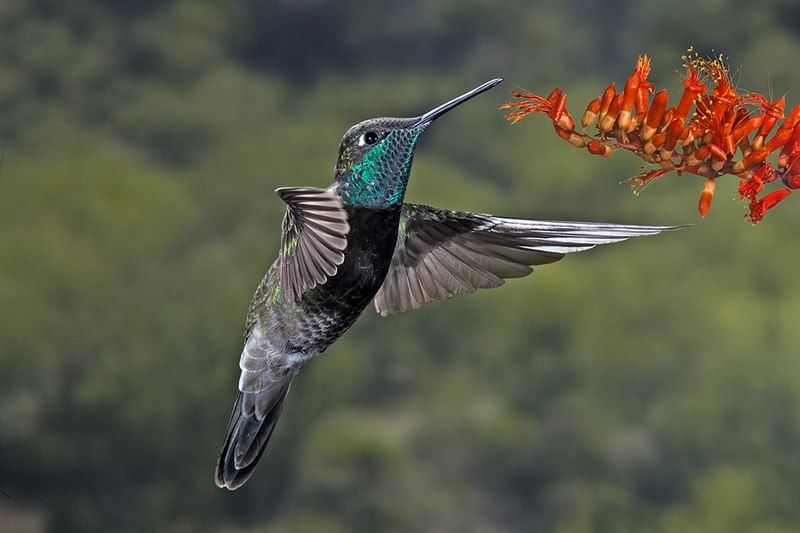
Rivoli’s hummingbird, also known as the magnificent hummingbird, is a species of hummingbird that belongs to the subfamily Trochilinae and tribe Lampornithini. It is part of a group of hummingbirds known as the “mountain gems.”
This species is found in Central America, specifically El Salvador, Guatemala, Honduras, Mexico, Nicaragua, and the United States. Rivoli’s hummingbird is a medium-sized species, averaging about 4.7 inches in length. Its plumage is a dazzling array of purples, blues, and greens.
The male’s head is a deep iridescent blue with a purple throat patch, while the female’s head is green with a white throat patch. The body is a mixture of blues and greens. Rivoli’s hummingbird is primarily a nectar feeder, supplementing its diet with insects and spiders.
It is commonly found near areas of flowering plants, where it forages and collects nectar. It is often seen in gardens, hovering midair while probing for nectar with its long bill.
Rivoli’s hummingbird is an important pollinator of many flowering plants, helping to ensure that the plants continue to survive and reproduce. Rivoli’s hummingbird is an essential species for conservation, as it is threatened by habitat loss in some parts of its range.
It is also vulnerable to climate change, as it depends on the availability of suitable food sources. For these reasons, it is essential to protect the habitats of Rivoli’s hummingbird and other species of hummingbirds to ensure their continued survival.
| Kingdom | Animalia |
| Phylum | Chordata |
| Class | Aves |
| Clade | Strisores |
| Order | Apodiformes |
| Family | Trochilidae |
| Genus | Eugenes |
| Species | E. fulgens |
11. New World Warblers
The New World warblers, also known as wood-warblers, are a family of small birds belonging to the Parulidae family. They are known for their colorful feathers and are native to the Americas, from Alaska to South America.
They are not related to Old World warblers, which are found in Europe, Africa, and Asia, or to Australian singers, which are found in Australia. New World warblers vary in size and color, but they all have some standard features.
They have short, pointed bills, strong legs, and short, rounded wings. Their feathers are often brightly colored, ranging from blues and greens to yellow, orange, and red.
They are usually found in wooded habitats, such as forests and woodlands, and feed mainly on insects and other invertebrates. These birds are known for their vocalizations, which can be heard yearly.
Many New World warblers have distinctive songs that can be heard during the breeding season.
These songs are used to communicate with other members of the same species, and they are often used to attract mates. New World warblers are essential to the environment, as they help to control insect populations.
They also help disperse seeds and pollinate flowers, essential for the ecosystem’s health. As a result, they are seen as an asset to the environment.
| Kingdom | Animalia |
| Phylum | Chordata |
| Class | Aves |
| Order | Passeriformes |
| Family | Parulidae |
Conclusion
Bluebirds are an essential and well-known species in South Dakota. Their presence is seen in many parts of the state, including wooded areas, prairies, and wetlands. Their populations are relatively stable, although certain areas are seeing a decrease in numbers.
Conservation efforts are being taken to ensure the continued presence of bluebirds in South Dakota, and with the help of concerned citizens, their future looks bright.